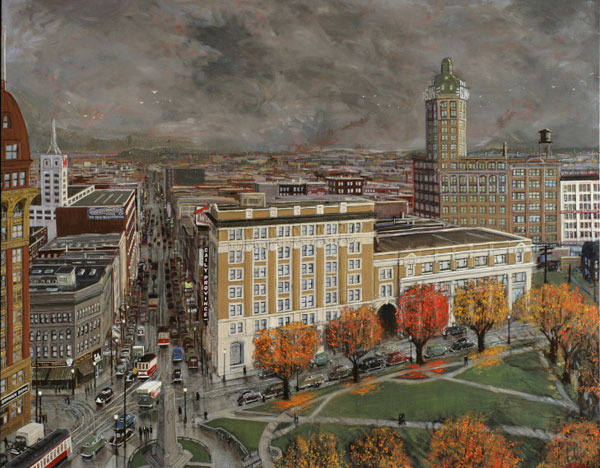

Art and urbanism rarely intersect. Sure, people talk about the ‘art of’ city planning; and street art is a staple of many cities. But capital ‘A’ fine-art rarely captures the intricacies of the urban environment. Tom Carter—a Vancouver painter and musician—is changing this. Unlike other local artists who focus on Vancouver’s natural beauty or aboriginal heritage, Tom is best known for his paintings that explore the sombre, gritty, working-class environment of cities, usually Vancouver.
Before turning to his easel, Tom owned and managed a recording studio for twenty years. Although he grew up in the suburbs and spent most of his early life in the suburbs, he always wanted an urban life. When he sold his studio a few years ago, Tom wasted little time in buying a downtown loft. As he made the move, he realized that he was the same age his grandfather was when he made a significant change, a generation earlier.
This coincidence intrigued him so much that he began to do some family research. Tom learned that his grandfather owned a series of restaurants in downtown Vancouver in the 1920s and 1930s. He was especially fascinated that one of these restaurants was across the street from what was, until recently, the Pantages Theatre on Hastings Street. His grandfather quickly walked away from the business in 1933 after a bomb went off at the theatre (then known as the Royal). The bombing was rumoured to be part of the labour unrest of the time.
This historical event propelled Tom to do a bit more research; not only into his family, but also that of his new neighbourhood. He feels that the best way to truly understand something is to draw it. The act of putting pencil to paper forces one to pay attention to the various details and intricacies that are often overlooked at first glance. Tom had always been artistic, but had devoted much of his talent to music until then. So he dusted of his painting skills and started working on a few pieces.
Tom quickly became known as the “Vancouver Guy” for his city noir renditions of Vancouver streets from the 1940s through the 1960s. He likes to paint this era for a variety of reasons. He finds the era resonates well with most viewers since they can relate to the period, but it is no longer emotionally charged.
On a personal level, it is the same era of his parents and grandparents. As such, he is able to merge various details from his family research into his paintings.
Finally, focusing on a past era reveals elements that are timeless. Styles and structures may change but truths do not.
Thus, while his work evokes the past, it not sentimental. Many viewers see street scenes that are still possible today. Tom admits that he is not only painting a city that was, but that could be and should be again.
The city that Tom paints is a city of neighbourhoods. This isn’t by accident. He lives on the edge of the Downtown Eastside, a neighbourhood that Tom calls one of the city’s most intact. The neighbourhood was passed over by much of the gentrification that has occurred in other parts of the city. It has also remained true to it’s working class social roots.
Jane Jacobs is also an inspiration of Tom’s. He notes that although some of his fellow residents have fallen on hard times, the community still looks out for one another, providing the eyes of the street that Jacobs famously promoted. Like Jacobs, Tom sees cities as a series of “supercharged small towns,” with each neighbourhood containing the basis of a small town complete with high streets, mixed uses and walkable communities.
Tom is currently showing at Baron Gallery in Gastown. Gallery owner Rosemary Baron was excited by the opportunity to showcase Tom’s work this year in recognition of the Vancouver’s 125th anniversary. Tom honours this occasion with several paintings from his Vancouver series featuring iconic 1950s intersections and neon signs from around the city.
The feature of the show is a project he calls Intersections. Intersections is an interactive, evolving painting that is comprised of multiple 18″x 24″ panels. It will never be complete; as people buy individual or groups of panels, they will be replaced by new paintings. The result is an organic evolving creation, similar to a city. He was inspired by the idea that we all live parallel lives that intersect at certain times or at certain places.
People relate to cities, not just based on place and space, but in time – a particular point in time. Tom’s own loft is an example of this. The building was once a leather goods factory. Where he paints today, somebody once cured leather. And one day somebody else will live yet another existence there.
Tom’s work has always represented intersections. His early street scenes are based on photographs from different eras. This allows him to include buildings that were not contemporaries, but that were important to the sense of place Tom wants to create. In this show he takes this concept one step further. Rather than being another representation of Vancouver, it is an amalgam of many places that Tom has visited; quite literally an intersection of place.
The modular concept of the work also allows for an intersection of time. Tom can replace pieces featuring different floors and rooms of the same building floors simultaneously. Alternatively, he is able to show the same site at a different point in its history. But perhaps the most interesting concept of the work is that it is meant to be broken up, with different people owning separate pieces of it—just like we each have our own little pieces of our real cities.
Coming full circle, these intersections reflect the urban environment that Tom loves, “a fascinating cross-section of society where people in very different situations must interact.”
You can interact with Tom’s work at Baron Galley (293 Columbia St.) through August 27th. It is well worth a visit!
***



